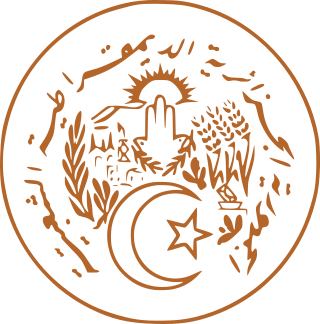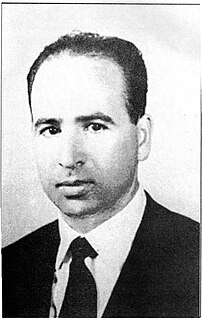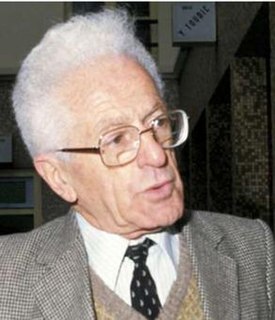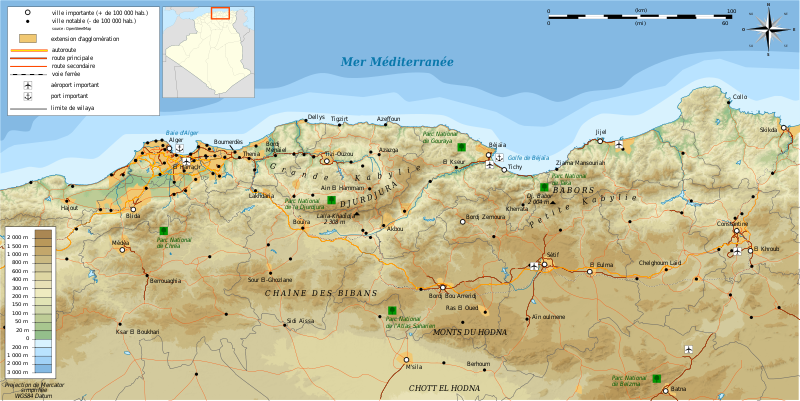Articles related to Algeria include:

Algeria since December 18, 2019, is divided into 58 wilayas (provinces). Prior to December 18, 2019, there were 48 provinces. The 58 provinces are divided into 1541 baladiyahs. The capital city of a baladiyah, daïra, or province, always gives those entities their name, even Algiers, the capital of the country gave it its name.

Kabyle, or Kabylian, is a Berber language spoken by the Kabyle people in the north and northeast of Algeria. It is spoken primarily in Kabylie, east of the capital Algiers and in Algiers itself, but also by various groups near Blida, such as the Beni Salah and Beni Bou Yaqob.(extinct?)

The official languages of Algeria are Arabic and Tamazight (Berber), as specified in its constitution since 1963 for the former and since 2016 for the latter. Berber has been recognized as a "national language" by constitutional amendment since 8 May 2002. In February, 2016, a constitutional resolution was passed making Berber an official language alongside Arabic. Algerian Arabic and Berber are the native languages of over 99% of Algerians, with Algerian Arabic spoken by about 72% and Berber by 27.4%. French, though it has no official status, is widely used in government, culture, media (newspapers) and education, due to Algeria's colonial history. Kabyle, the most spoken Berber language in the country, is taught and partially co-official in parts of Kabylie.

The Bejaia province, stylized Béjaïa in French, is a province of Algeria in the Kabylie region. The province's capital city is Béjaïa.

Berberism or Amazighism is a Berber political-cultural movement of ethnic, geographic, or cultural nationalism, started mainly in Kabylia, Algeria and in Morocco, later spreading to the rest of the Berber communities in the Maghreb region of North Africa. A Berber group, the Tuaregs, have been in rebellion against Mali since 2012, and established a temporarily de facto independent state called Azawad, which identified itself as Berber.

Abane Ramdane was an Algerian political activist and revolutionary born in Kabylie. He played a key role in the organization of the independence struggle during the Algerian war. His influence was so great that he was known as "the architect of the revolution". He was also the architect of the Soummam conference Bejaia in 1956 and was very close to Frantz Fanon.

Krim Belkacem was an Algerian revolutionary fighter and politician.

Ferhat Mehenni, also known as Ferhat Imazighen Imula, is a Kabyle artist, a political activist and the founder and first President of the Movement for the Autonomy of Kabylie. Since 1 June 2010 he has been the President of the Provisional Government of Kabylia, a government in exile that the movement set up in France. He has been a Laureate of the Gusi Peace Prize since 23 July 2013.
The Berber Spring was a period of political protest and civil activism in 1980 claiming recognition of the Berber identity and language in Algeria with events mainly taking place in Kabylie and Algiers.

The Kabyle people are a Berber people indigenous to Kabylia in the north of Algeria, spread across the Atlas Mountains, one hundred miles east of Algiers. They represent the largest Berber-speaking population of Algeria and the second largest in North Africa.

Jeunesse Sportive de Kabylie, known as JS Kabylie or JSK, is an Algerian football club based in Tizi Ouzou. The club are named after the cultural, natural and historical region that is home to the Berber-speaking Kabyle. The club was founded in 1946 and its colours are green and yellow. Their home stadium, Stade du 1er Novembre 1954, has a capacity of 21,240 spectators. The club is currently playing in the Algerian Ligue Professionnelle 1.

Mouloud Mammeri was an Algerian writer, anthropologist and linguist.

Bouzeguene is a Kabyle town in Tizi Ouzou Province, Algeria, approximately 170 km from Algiers.

Aokas is a coastal city and district in the Béjaïa Province in northern Algeria and is located at about 25 kilometres from the province's capital city of Bgayet. The commune of Aokas was created by decree of October 2, 1869. It covered an area of 2,202 hectares and had a population of 2,245 inhabitants in 1931. Its name in berber means shark. Its average altitude is 300 meters.

El Kseur is a town in northern Algeria.

Bou-Nouh is a town and commune in Tizi Ouzou Province in northern Algeria.

Tadmaït is a town and commune in Tizi Ouzou Province in northern Algeria, located 18 kilometers west of Tizi Ouzou and 85 kilometers est of Algiers.

The Kingdom of the Ait Abbas or Sultanate of the Beni Abbas, was a Berber state of North Africa, then a fief and a principality, controlling Lesser Kabylie and its surroundings from the sixteenth century to the nineteenth century. It is referred to in the Spanish historiography as "reino de Labes"; sometimes more commonly referred to by its ruling family, the Mokrani, in Berber At Muqran. Its capital was the Kalâa of Ait Abbas, an impregnable citadel in the Biban mountain range.
Mohamed Seghir Boushaki, was an Algerian Berber politician after the French conquest of Algeria.

























